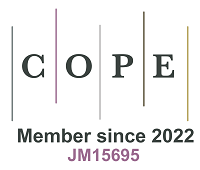REFERENCES
1. Rossiello F, Jurk D, Passos JF, d’Adda di Fagagna F. Telomere dysfunction in ageing and age-related diseases. Nat Cell Biol 2022;24:135-47.
2. Lin J, Epel E. Stress and telomere shortening: insights from cellular mechanisms. Ageing Res Rev 2022;73:101507.
4. Chakravarti D, LaBella KA, DePinho RA. Telomeres: history, health, and hallmarks of aging. Cell 2021;184:306-22.
5. Armstrong E, Boonekamp J. Does oxidative stress shorten telomeres in vivo? A meta-analysis. Ageing Res Rev 2023;85:101854.
6. Kordowitzki P. Oxidative stress induces telomere dysfunction and shortening in human oocytes of advanced age donors. Cells 2021;10:1866.
7. Barnes RP, Fouquerel E, Opresko PL. The impact of oxidative DNA damage and stress on telomere homeostasis. Mech Ageing Dev 2019;177:37-45.
8. He Y, Feigon J. Telomerase structural biology comes of age. Curr Opin Struct Biol 2022;76:102446.
9. Wang C, Meier UT. Architecture and assembly of mammalian H/ACA small nucleolar and telomerase ribonucleoproteins. EMBO J 2004;23:1857-67.
11. Saretzki G, Wan T. Telomerase in brain: the new kid on the block and its role in neurodegenerative diseases. Biomedicines 2021;9:490.
12. Eitan E, Braverman C, Tichon A, et al. Excitotoxic and radiation stress increase TERT levels in the mitochondria and cytosol of cerebellar purkinje neurons. Cerebellum 2016;15:509-17.
13. Zhao F, Qu Y, Xiong T, Duan Z, Ye Q, Mu D. The neuroprotective role of TERT via an antiapoptotic mechanism in neonatal rats after hypoxia-ischemia brain injury. Neurosci Lett 2012;515:39-43.
14. Yu X, Liu MM, Zheng CY, Liu YT, Wang Z, Wang ZY. Telomerase reverse transcriptase and neurodegenerative diseases. Front Immunol 2023;14:1165632.
15. Nie L, Yao D, Chen S, et al. Directional induction of neural stem cells, a new therapy for neurodegenerative diseases and ischemic stroke. Cell Death Discov 2023;9:215.
16. Wilson DM 3rd, Cookson MR, Van Den Bosch L, Zetterberg H, Holtzman DM, Dewachter I. Hallmarks of neurodegenerative diseases. Cell 2023;186:693-714.
17. Ding X, Liu X, Wang F, Wang F, Geng X. Role of senescence and neuroprotective effects of telomerase in neurodegenerative diseases. Rejuvenation Res 2020;23:150-8.
18. Gao X, Yu X, Zhang C, et al. Telomeres and mitochondrial metabolism: implications for cellular senescence and age-related diseases. Stem Cell Rev Rep 2022;18:2315-27.
19. Fumagalli M, Rossiello F, Clerici M, et al. Telomeric DNA damage is irreparable and causes persistent DNA-damage-response activation. Nat Cell Biol 2012;14:355-65.
20. Hewitt G, Jurk D, Marques FDM, et al. Telomeres are favoured targets of a persistent DNA damage response in ageing and stress-induced senescence. Nat Commun 2012;3:708.
21. Topiwala A, Nichols TE, Williams LZJ, et al. Telomere length and brain imaging phenotypes in UK Biobank. PLoS One 2023;18:e0282363.
22. Liu R, Xiang M, Pilling LC, et al. Mid-life leukocyte telomere length and dementia risk: an observational and mendelian randomization study of 435,046 UK Biobank participants. Aging Cell 2023;22:e13808.
23. Scarabino D, Broggio E, Gambina G, Corbo RM. Leukocyte telomere length in mild cognitive impairment and Alzheimer’s disease patients. Exp Gerontol 2017;98:143-7.
24. Liu Q, Li Z, Huang L, et al. Telomere and mitochondria mediated the association between dietary inflammatory index and mild cognitive impairment: a prospective cohort study. Immun Ageing 2023;20:1.
25. Liu Q, Zhou D, Duan H, et al. Association of dietary inflammatory index and leukocyte telomere length with mild cognitive impairment in Chinese older adults. Nutr Neurosci 2023;26:50-9.
26. Diukov Y, Bachinskaya N, Dzobak A, et al. Association of telomere length with cognitive impairment. J Mol Neurosci 2023;73:448-55.
27. Lin MT, Beal MF. Mitochondrial dysfunction and oxidative stress in neurodegenerative diseases. Nature 2006;443:787-95.
28. Teleanu DM, Niculescu AG, Lungu II, et al. An overview of oxidative stress, neuroinflammation, and neurodegenerative diseases. Int J Mol Sci 2022;23:5938.
29. Johnson J, Mercado-Ayon E, Mercado-Ayon Y, et al. Mitochondrial dysfunction in the development and progression of neurodegenerative diseases. Arch Biochem Biophys 2021;702:108698.
30. Sahin E, Colla S, Liesa M, et al. Telomere dysfunction induces metabolic and mitochondrial compromise. Nature 2011;470:359-65.
32. Barnes RP, de Rosa M, Thosar SA, et al. Telomeric 8-oxo-guanine drives rapid premature senescence in the absence of telomere shortening. Nat Struct Mol Biol 2022;29:639-52.
33. Martínez P, Blasco MA. Telomeric and extra-telomeric roles for telomerase and the telomere-binding proteins. Nat Rev Cancer 2011;11:161-76.
34. Baruch-Eliyahu N, Rud V, Braiman A, Priel E. Telomerase increasing compound protects hippocampal neurons from amyloid beta toxicity by enhancing the expression of neurotrophins and plasticity related genes. Sci Rep 2019;9:18118.
35. Shim HS, Horner JW, Wu CJ, et al. Telomerase reverse transcriptase preserves neuron survival and cognition in Alzheimer’s disease models. Nat Aging 2021;1:1162-74.
36. Ahmed S, Passos JF, Birket MJ, et al. Telomerase does not counteract telomere shortening but protects mitochondrial function under oxidative stress. J Cell Sci 2008;121:1046-53.
37. Spilsbury A, Miwa S, Attems J, Saretzki G. The role of telomerase protein TERT in Alzheimer’s disease and in tau-related pathology in vitro. J Neurosci 2015;35:1659-74.
38. Miwa S, Czapiewski R, Wan T, et al. Decreased mTOR signalling reduces mitochondrial ROS in brain via accumulation of the telomerase protein TERT within mitochondria. Aging 2016;8:2551-67.
39. Miwa S, Saretzki G. Telomerase and mTOR in the brain: the mitochondria connection. Neural Regen Res 2017;12:358-61.
41. Prieto-Oliveira P. Telomerase activation in the treatment of aging or degenerative diseases: a systematic review. Mol Cell Biochem 2021;476:599-607.
42. Wang J, Liu Y, Xia Q, et al. Potential roles of telomeres and telomerase in neurodegenerative diseases. Int J Biol Macromol 2020;163:1060-78.
44. Alzheimer’s Association Report. 2023 Alzheimer’s disease facts and figures. Alzheimers Dement 2023;19:1598-695.
46. Passeri E, Elkhoury K, Morsink M, et al. Alzheimer’s disease: treatment strategies and their limitations. Int J Mol Sci 2022;23:13954.
48. Ma F, Lv X, Du Y, et al. Association of leukocyte telomere length with mild cognitive impairment and Alzheimer’s disease: role of folate and homocysteine. Dement Geriatr Cogn Disord 2019;48:56-67.
49. Forero DA, González-Giraldo Y, López-Quintero C, Castro-Vega LJ, Barreto GE, Perry G. Meta-analysis of telomere length in Alzheimer’s disease. J Gerontol A Biol Sci Med Sci 2016;71:1069-73.
50. Fu J, Ji X, Liu J, Chen X, Shang H. Meta-analysis of the connection between Alzheimer disease and telomeres. Alzheimer Dis Assoc Disord 2022;36:73-9.
51. Lee EH, Han MH, Ha J, et al. Relationship between telomere shortening and age in Korean individuals with mild cognitive impairment and Alzheimer’s disease compared to that in healthy controls. Aging 2020;13:2089-100.
52. Cao Z, Hou Y, Xu C. Leucocyte telomere length, brain volume and risk of dementia: a prospective cohort study. Gen Psychiatr 2023;36:e101120.
53. Martínez-González K, Islas-Hernández A, Martínez-Ezquerro JD, Bermúdez-Rattoni F, Garcia-delaTorre P. Telomere length and oxidative stress variations in a murine model of Alzheimer’s disease progression. Eur J Neurosci 2020;52:4863-74.
54. Guan JZ, Guan WP, Maeda T, Makino N. Analysis of telomere length and subtelomeric methylation of circulating leukocytes in women with Alzheimer’s disease. Aging Clin Exp Res 2013;25:17-23.
55. Hinterberger M, Fischer P, Huber K, Krugluger W, Zehetmayer S. Leukocyte telomere length is linked to vascular risk factors not to Alzheimer’s disease in the VITA study. J Neural Transm 2017;124:809-19.
56. Scarabino D, Broggio E, Gambina G, Pelliccia F, Corbo RM. Common variants of human TERT and TERC genes and susceptibility to sporadic Alzheimers disease. Exp Gerontol 2017;88:19-24.
57. Hu Y, Fryatt GL, Ghorbani M, et al. Replicative senescence dictates the emergence of disease-associated microglia and contributes to Aβ pathology. Cell Rep 2021;35:109228.
58. Raj DDA, Moser J, van der Pol SM, et al. Enhanced microglial pro-inflammatory response to lipopolysaccharide correlates with brain infiltration and blood-brain barrier dysregulation in a mouse model of telomere shortening. Aging Cell 2015;14:1003-13.
59. Wang J, Zhao C, Zhao A, Li M, Ren J, Qu X. New insights in amyloid beta interactions with human telomerase. J Am Chem Soc 2015;137:1213-9.
60. Whittemore K, Derevyanko A, Martinez P, et al. Telomerase gene therapy ameliorates the effects of neurodegeneration associated to short telomeres in mice. Aging 2019;11:2916-48.
61. Park HH, Lee KY, Kim S, et al. The novel vaccine peptide GV1001 effectively blocks β-amyloid toxicity by mimicking the extra-telomeric functions of human telomerase reverse transcriptase. Neurobiol Aging 2014;35:1255-74.
62. Eitan E, Tichon A, Gazit A, Gitler D, Slavin S, Priel E. Novel telomerase-increasing compound in mouse brain delays the onset of amyotrophic lateral sclerosis. EMBO Mol Med 2012;4:313-29.
63. Tolosa E, Garrido A, Scholz SW, Poewe W. Challenges in the diagnosis of Parkinson’s disease. Lancet Neurol 2021;20:385-97.
64. Bryois J, Skene NG, Hansen TF, et al. Genetic identification of cell types underlying brain complex traits yields insights into the etiology of Parkinson’s disease. Nat Genet 2020;52:482-93.
65. Kam TI, Mao X, Park H, et al. Poly(ADP-ribose) drives pathologic α-synuclein neurodegeneration in Parkinson’s disease. Science 2018;362:eaat8407.
66. Chen R, Zhan Y. Association between telomere length and Parkinson’s disease: a Mendelian randomization study. Neurobiol Aging 2021;97:144.e9-11.
67. Guan JZ, Maeda T, Sugano M, et al. A percentage analysis of the telomere length in Parkinson’s disease patients. J Gerontol A Biol Sci Med Sci 2008;63:467-73.
68. Scheffold A, Holtman IR, Dieni S, et al. Telomere shortening leads to an acceleration of synucleinopathy and impaired microglia response in a genetic mouse model. Acta Neuropathol Commun 2016;4:87.
69. Martin-Ruiz C, Williams-Gray CH, Yarnall AJ, et al. Senescence and inflammatory markers for predicting clinical progression in Parkinson’s disease: the ICICLE-PD study. J Parkinsons Dis 2020;10:193-206.
70. Levstek T, Redenšek S, Trošt M, Dolžan V, Podkrajšek KT. Assessment of the telomere length and its effect on the symptomatology of Parkinson’s disease. Antioxidants 2021;10:137.
71. Wan T, Weir EJ, Johnson M, Korolchuk VI, Saretzki GC. Increased telomerase improves motor function and alpha-synuclein pathology in a transgenic mouse model of Parkinson’s disease associated with enhanced autophagy. Prog Neurobiol 2021;199:101953.
72. Mead RJ, Shan N, Reiser HJ, Marshall F, Shaw PJ. Amyotrophic lateral sclerosis: a neurodegenerative disorder poised for successful therapeutic translation. Nat Rev Drug Discov 2023;22:185-212.
74. Xu L, Liu T, Liu L, et al. Global variation in prevalence and incidence of amyotrophic lateral sclerosis: a systematic review and meta-analysis. J Neurol 2020;267:944-53.
75. Xia K, Zhang L, Zhang G, Wang Y, Huang T, Fan D. Leukocyte telomere length and amyotrophic lateral sclerosis: a Mendelian randomization study. Orphanet J Rare Dis 2021;16:508.
76. Wan M, Qin J, Songyang Z, Liu D. OB fold-containing protein 1 (OBFC1), a human homolog of yeast Stn1, associates with TPP1 and is implicated in telomere length regulation. J Biol Chem 2009;284:26725-31.
77. Levy D, Neuhausen SL, Hunt SC, et al. Genome-wide association identifies OBFC1 as a locus involved in human leukocyte telomere biology. Proc Natl Acad Sci U S A 2010;107:9293-8.
78. Geng Y, Liu C, Cai Q, et al. Crystal structure of parallel G-quadruplex formed by the two-repeat ALS- and FTD-related GGGGCC sequence. Nucleic Acids Res 2021;49:5881-90.
79. Lansdorp PM. Sex differences in telomere length, lifespan, and embryonic dyskerin levels. Aging Cell 2022;21:e13614.
80. Gutierrez-Rodrigues F, Alves-Paiva RM, Scatena NF, Martinez EZ, Scheucher PS, Calado RT. Association between leukocyte telomere length and sex by quantile regression analysis. Hematol Transfus Cell Ther 2022;44:346-51.
81. Taheri M, Ghafouri-Fard S, Najafi S, et al. Hormonal regulation of telomerase activity and hTERT expression in steroid-regulated tissues and cancer. Cancer Cell Int 2022;22:258.
82. Simoncini T, Hafezi-Moghadam A, Brazil DP, Ley K, Chin WW, Liao JK. Interaction of oestrogen receptor with the regulatory subunit of phosphatidylinositol-3-OH kinase. Nature 2000;407:538-41.
83. Grasselli A, Nanni S, Colussi C, et al. Estrogen receptor-α and endothelial nitric oxide synthase nuclear complex regulates transcription of human telomerase. Circ Res 2008;103:34-42.
84. Heitzer M, Kaiser S, Kanagaratnam M, et al. Administration of 17β-estradiol improves motoneuron survival and down-regulates inflammasome activation in male SOD1(G93A) ALS mice. Mol Neurobiol 2017;54:8429-43.
85. Groeneveld GJ, Van Muiswinkel FL, Sturkenboom JM, Wokke JHJ, Bär PR, Van den Berg LH. Ovariectomy and 17β-estradiol modulate disease progression of a mouse model of ALS. Brain Res 2004;1021:128-31.
86. Ornish D, Lin J, Daubenmier J, et al. Increased telomerase activity and comprehensive lifestyle changes: a pilot study. Lancet Oncol 2008;9:1048-57.
87. Tabrizi SJ, Estevez-Fraga C, van Roon-Mom WMC, et al. Potential disease-modifying therapies for Huntington’s disease: lessons learned and future opportunities. Lancet Neurol 2022;21:645-58.
88. PerezGrovas-Saltijeral A, Ochoa-Morales A, Miranda-Duarte A, et al. Telomere length analysis on leukocytes derived from patients with Huntington disease. Mech Ageing Dev 2020;185:111189.
89. Morena E, Romano C, Marconi M, et al. Peripheral biomarkers in manifest and premanifest Huntington’s disease. Int J Mol Sci 2023;24:6051.
90. Scarabino D, Veneziano L, Fiore A, et al. Leukocyte telomere length variability as a potential biomarker in patients with PolyQ diseases. Antioxidants 2022;11:1436.
91. Scarabino D, Veneziano L, Peconi M, Frontali M, Mantuano E, Corbo RM. Leukocyte telomere shortening in Huntington’s disease. J Neurol Sci 2019;396:25-9.
92. Scarabino D, Veneziano L, Mantuano E, et al. Leukocyte telomere length as potential biomarker of HD progression: a follow-up study. Int J Mol Sci 2022;23:13449.
93. Castaldo I, De Rosa M, Romano A, et al. DNA damage signatures in peripheral blood cells as biomarkers in prodromal huntington disease. Ann Neurol 2019;85:296-301.
96. McGinley MP, Goldschmidt CH, Rae-Grant AD. Diagnosis and treatment of multiple sclerosis: a review. JAMA 2021;325:765-79.
97. Hinsinger G, Galéotti N, Nabholz N, et al. Chitinase 3-like proteins as diagnostic and prognostic biomarkers of multiple sclerosis. Mult Scler 2015;21:1251-61.
98. Hecker M, Fitzner B, Jäger K, et al. Leukocyte telomere length in patients with multiple sclerosis and its association with clinical phenotypes. Mol Neurobiol 2021;58:2886-96.
99. Krysko KM, Henry RG, Cree BAC; University of California, San Francisco MS-EPIC Team. Telomere length is associated with disability progression in multiple sclerosis. Ann Neurol 2019;86:671-82.
100. Guan JZ, Guan WP, Maeda T, Guoqing X, GuangZhi W, Makino N. Patients with multiple sclerosis show increased oxidative stress markers and somatic telomere length shortening. Mol Cell Biochem 2015;400:183-7.
101. Guan JZ, Guan WP, Maeda T. Vitamin E administration erases an enhanced oxidation in multiple sclerosis. Can J Physiol Pharmacol 2018;96:1181-3.
102. Rothblum-Oviatt C, Wright J, Lefton-Greif MA, McGrath-Morrow SA, Crawford TO, Lederman HM. Ataxia telangiectasia: a review. Orphanet J Rare Dis 2016;11:159.
103. Mitiagin Y, Barzilai A. Ataxia-telangiectasia mutated plays an important role in cerebellar integrity and functionality. Neural Regen Res 2023;18:497-502.
104. Lee JH, Paull TT. Cellular functions of the protein kinase ATM and their relevance to human disease. Nat Rev Mol Cell Biol 2021;22:796-814.
105. Wang H, Shi LZ, Wong CCL, et al. The interaction of CtIP and Nbs1 connects CDK and ATM to regulate HR-mediated double-strand break repair. PLoS Genet 2013;9:e1003277.
106. Riballo E, Kühne M, Rief N, et al. A pathway of double-strand break rejoining dependent upon ATM, Artemis, and proteins locating to γ-H2AX foci. Mol Cell 2004;16:715-24.
109. Kishi S, Zhou XZ, Ziv Y, et al. Telomeric protein Pin2/TRF1 as an important ATM target in response to double strand DNA breaks. J Biol Chem 2001;276:29282-91.
110. van Steensel B, de Lange T. Control of telomere length by the human telomeric protein TRF1. Nature 1997;385:740-3.
111. Kishi S, Lu KP. A critical role for Pin2/TRF1 in ATM-dependent regulation. Inhibition of Pin2/TRF1 function complements telomere shortening, radiosensitivity, and the G2/M checkpoint defect of ataxia-telangiectasia cells. J Biol Chem 2002;277:7420-9.
112. Chen W, Liu S, Hu H, et al. Novel homozygous ataxia-telangiectasia (A-T) mutated gene mutation identified in a Chinese pedigree with A-T. Mol Med Rep 2019;20:1655-62.
113. Wood LD, Halvorsen TL, Dhar S, et al. Characterization of ataxia telangiectasia fibroblasts with extended life-span through telomerase expression. Oncogene 2001;20:278-88.
114. Pintado-Berninches L, Fernandez-Varas B, Benitez-Buelga C, et al. GSE4 peptide suppresses oxidative and telomere deficiencies in ataxia telangiectasia patient cells. Cell Death Differ 2019;26:1998-2014.
115. Machado-Pinilla R, Sánchez-Pérez I, Murguía JR, Sastre L, Perona R. A dyskerin motif reactivates telomerase activity in X-linked dyskeratosis congenita and in telomerase-deficient human cells. Blood 2008;111:2606-14.
116. Iarriccio L, Manguán-García C, Pintado-Berninches L, et al. GSE4, a small dyskerin- and GSE24.2-related peptide, induces telomerase activity, cell proliferation and reduces DNA damage, oxidative stress and cell senescence in dyskerin mutant cells. PLoS One 2015;10:e0142980.
117. Descloux C, Ginet V, Clarke PGH, Puyal J, Truttmann AC. Neuronal death after perinatal cerebral hypoxia-ischemia: focus on autophagy-mediated cell death. Int J Dev Neurosci 2015;45:75-85.
118. Greco P, Nencini G, Piva I, et al. Pathophysiology of hypoxic-ischemic encephalopathy: a review of the past and a view on the future. Acta Neurol Belg 2020;120:277-88.
119. Nakajima W, Ishida A, Lange MS, et al. Apoptosis has a prolonged role in the neurodegeneration after hypoxic ischemia in the newborn rat. J Neurosci 2000;20:7994-8004.
120. Wang Y, Jiao F, Zheng H, et al. Gender difference in associations between telomere length and risk factors in patients with stroke. Front Aging Neurosci 2021;13:719538.
121. Marinaccio J, Micheli E, Udroiu I, et al. TERT extra-telomeric roles: antioxidant activity and mitochondrial protection. Int J Mol Sci 2023;24:4450.
122. Zhao FY, Qu Y, Zhang L, et al. [The neuroprotective role of exogenous TERT gene in neonatal rats with hypoxic-ischemic brain damage]. Zhongguo Dang Dai Er Ke Za Zhi 2016;18:1296-301. (in Chinese).
123. Li J, Qu Y, Chen D, et al. The neuroprotective role and mechanisms of TERT in neurons with oxygen-glucose deprivation. Neuroscience 2013;252:346-58.
124. Del Bufalo D, Rizzo A, Trisciuoglio D, et al. Involvement of hTERT in apoptosis induced by interference with Bcl-2 expression and function. Cell Death Differ 2005;12:1429-38.
125. Massard C, Zermati Y, Pauleau AL, et al. hTERT: a novel endogenous inhibitor of the mitochondrial cell death pathway. Oncogene 2006;25:4505-14.
126. Zhang L, Li S, Chen L, et al. Retracted: Cerebellar fastigial nucleus electrical stimulatin protects against cerebral ischemic damage by upregulating telomerase activity. Restor Neurol Neurosci 2019;37:131-41.







